The Berliner Dom (Berlin Cathedral) was built between 1894 and 1905 on an island in the river Spree now known as Museum Island. The church, the largest in the city, was heavily damaged during the war and only reopened in 1993.
Despite its name, the Berlin Cathedral is not an actual cathedral, since the church is not the seat of a bishop.
History
The first churches
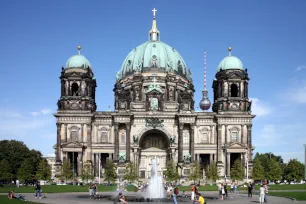
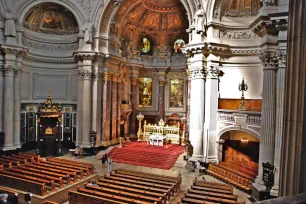
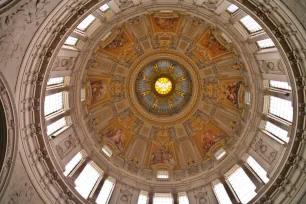
A first church on this site was built in 1465. This rather modest building later served as the court church for the Hohenzollern family, whose palace was just across the street. The church was replaced by a cathedral, built in 1745-1747 to a Baroque design from Johann Boumann. Between 1816 and 1822 it was remodeled into a classicist building, following a design by the esteemed Berlin architect Karl Friedrich Schinkel.
Construction
On the order of Emperor William II, this domed building was demolished in 1894 to make way for the current cathedral, which was completed in 1905. Much larger than any of the previous buildings, it was meant as a protestant counterweight to the Catholic St. Peter’s Basilica in Rome. Hence, it is unusually ornate for a Protestant church.
The domed cathedral, measuring 144 by 73 meters (472 x 240 ft), was designed by Julius Raschdorff in a High Renaissance style accentuated with rich Baroque decorations.
War damage
During the Second World War, the cathedral was hit by a firebomb, which severely damaged much of the building. A temporary roof was installed to protect what remained of the interior and – despite plans by the East German government to demolish the building – in 1975 reconstruction of the church started.
The restoration of the interior begun in 1984 and in 1993 the cathedral reopened. It was consecrated for the second time in 1996. Meanwhile, restoration work continued until 2002. During reconstruction, the original design was simplified; the cupolas that crowned the domes, for instance, were removed. The Hohenzollern mausoleum that was located at the north side of the building was also removed in the process.
The Cathedral

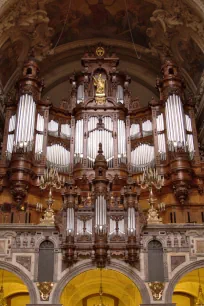

Interior
The interior is opulent and shows Emperor William II’s liking for ostentation. Marble columns and gilded ornaments are in abundance.
The chancel features three stained-glass windows, created by Anton von Werner, that depict the birth, crucifixion and resurrection of Christ. The main altar was created by Friedrich August Stüler for the cathedral’s predecessor and is made of white marble and yellow onyx. The nearby pulpit was hand carved in oak following a design by Otto Raschdorff, son of the cathedral’s architect.
One of the most interesting items in the cathedral is the reconstructed pipe organ, built by the Wilhelm Sauer manufactory. The organ, originally constructed in 1905, has more than 7,000 pipes.
Below the organ is a beautifully sculpted sarcophagus made for the Great Elector, Frederick William. On the opposite side you find an even more magnficent sarcophagus, sculpted by Andreas Schlüter for King Frederick I. Adjacent is the Tauf- and Traukirche, a chapel used for baptisms and marriages.
The magnificent dome, which reaches a height of 98 meters (322 ft), is decorated with mosaics created by Anton von Werner. To get an overview of the interior, walk to the Kaiserliches Treppenhaus (Imperial Stairwell), and climb the 267 steps to the gallery right below the dome.
Along the way you pass the cathedral’s museum, which displays plenty of scale models, ornaments, historical photos of the cathedral and background information about its history. Once at the top, you can walk outside around the dome for fantastic views over the city.
Crypt
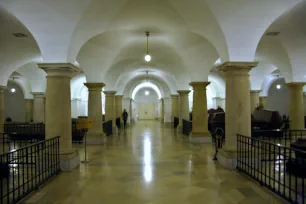
In total, there are 94 coffins and sarcophagi of royals in the cathedral. Some of these are in the main church. Among them the tomb of elector Johann Cicero (†1499), elector of Brandenburg, the oldest (1530) tomb in the cathedral. Other members of the Hohenzollern family are buried in the Hohenzollerngruft, the cathedral’s crypt in the basement.

